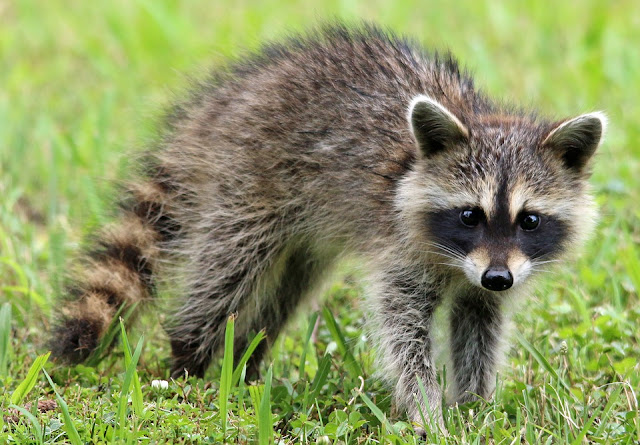Procyonids are medium-sized omnivores that range throughout much of North America. Raccoons, coatis, and ringtails feed on insects, small mammals, birds, lizards, and fruits. Ringtails are much smaller and slenderer than raccoons and consume a higher proportion of animal matter. Coatis are slightly smaller than racoons and are limited in their distribution in the United States to just north of the Mexican border.
The raccoon (Procyon lotor) is the most abundant and widespread medium-sized omnivore in the North America. They are found throughout Mexico, Central America, the United States. Except at the higher elevations of the Rocky Mountains, and into southern Canada. During the last 50 years, raccoon populations in the United States have increased greatly.
Raccoon Nocturnal
In suburban areas, they frequently raid garbage cans and dumps. Raccoons are preyed on by bobcats, coyotes, foxes, and great horned owls. Twenty-five subspecies are recognized in the United States and Canada.
However, most investigators do not identify the subspecies studied because different subspecies inhabit essentially nonoverlapping geographic ranges. Though raccoons are mainly nocturnal, they do often get some stuff done during the day. Hence traditionally they come out only during the nighttime hours to scrounge for food. Moreover, many humans hear raccoon noises at night due to their nocturnal habits.
Body Size
Raccoons measure from 46 to 71 cm with a 20 to 30 cm tail. Body weights vary by location, age, and sex from 3 to 9 kg. The largest raccoons recorded are from Idaho and nearby states, while the smallest reside in the Florida Keys. Juveniles do not reach adult size until at least the end of their second year.
In the autumn, fat reserves account for 20 to 30 percent or more of the raccoon's weight.
The juveniles gained weight almost linearly until mid-November, after which they began to lose weight until April. Weight loss in adults and yearlings can reach 50 percent during the 4 months of winter dormancy (e.g., 4.3-kg loss for a 9.1-kg raccoon). Raccoons are active all year, winter weight losses are less, 16 to 17 percent on average.
Habitat
Raccoons are found near virtually every aquatic habitat, particularly in hardwood swamps, mangroves, floodplain forests, and freshwater and saltwater marshes. They are also common in suburban residential areas and cultivated and abandoned farmlands and may forage in farmyards. The permanent water supply, tree dens, and available food are essential. Raccoons use surface waters for both drinking and foraging.
Food Habits
The raccoon is an omnivorous and opportunistic feeder. Although primarily active from sunset to sunrise. The raccoons will change their activity period to accommodate the availability of food and water.
The salt marsh raccoons may become active during the day to take advantage of low tide. Raccoons feed primarily on fleshy fruits, nuts, acorns, and corn but also eat grains, insects, frogs, crayfish, eggs, and virtually any animal and vegetable matter.
The proportion of different foods in their diet depends on location and season, although plants are usually a more important component of the diet. They may focus on a preferred food, such as turtle eggs, when it is available.
They also will feed on garbage and carrion. Typically, it is only in the spring and early summer that raccoons eat more animal than plant material. Their late summer and fall diets consist primarily of fruits. In winter, acorns tend to be the most important food, although raccoons will take any corn or fruits that are still available.
Temperature Regulation and Molt
From the central United States into Canada, raccoons undergo a winter dormancy lasting up to 4 months. It is not a true hibernation, however, and they can be easily awakened. Animals in the south are active year-round. Snow cover, more than low temperatures, triggers winter dormancy. The raccoon's annual molt begins early in spring and lasts about 3 months.
Breeding activities and social organization
Although solitary, adult raccoons come together for a short time during the mating period. Which begins earlier (January to March) in their northern range than in their southern range (March to June). Male and female home ranges overlap freely, and each male may mate with several females during the breeding season.
The most common group of raccoons is a mother and her young of that year. Further north in their range, a family will den together for the winter and break up the following spring. Males are territorial toward one another but not toward females; females are not territorial.
Home Range and Resources
The size of a raccoon's home range depends on its sex and age, habitat, food sources, and the season. Values from a few hectares to more than a few thousand hectares have been reported, although home ranges of a few hundred hectares appear to be most common.
In general, home ranges of males are larger than those of females, the home range of females with young is restricted, and winter ranges are smaller than ranges at other times of the year for both sexes. During the winter, raccoons commonly den in hollow trees.
They also use the burrows of other animals such as foxes, groundhogs, skunks, and badgers. These sites are used for sleeping during warmer periods. After wintering in one den, the female will choose a new den in which to bear her young. The cubs leave the den, the family will not use it again that year.
Population Density
Population density depends on the quality and quantity of food resources and den sites. Values between 0.005 and 1.5 raccoons per hectare have been reported, although 0.1 to 0.2 per hectare is more common.
Populations exceeding one raccoon per hectare have been reported in residential areas. Although raccoons may prefer tree dens over ground dens, particularly for raising young. The raccoon densities in an area with few tree dens but numerous ground dens.
Males generally are not sexually mature by the time of the first regular breeding season following their birth, but they may mature later that summer or fall. Females may become pregnant in their first year. In a review of several studies, that up to 60 percent of both wild and captive females’ mate and produce litters in their first year.
The pregnancy rates of yearlings from 38 to 77 percent. After their first year, almost all females breed annually. Females produce only one litter each year, and the female alone cares for the young. With some exceptions the larger litter sizes usually occur in the raccoon's northern range.
Some juveniles of both sexes disperse from the areas where they were born during the fall or winter of their first year, while others stay and raise young within their parents' home range. The highest mortality rates occur within the first 2 years; the age structure of populations in Alabama suggests that mortality is higher for subadults than for juveniles.
Raccoon Noises
Raccoon is famous to make different type of sounds, i.e., purring, low grunt, loud purr, chittering, growling, snarling, whimpering, hissing, and screeching like owl’s whistle. However, juvenile raccoon sounds consist of crying, whining, and mewing. Raccoon make growl noise when they feel any danger indicate the presence to home owner.
Similar Species
- The coati (Nasua nasua) is slightly smaller than the raccoon (4 to 6 kg) but with a much longer tail (51 to 64 cm). Ranging throughout Central America from Panama to Mexico. The coati is rare in the United States where it inhabits open forests of the southwest, near the Mexican border.
It forages primarily for grubs and tubers but also feeds on fruits, nuts, bird eggs, lizards, scorpions, and tarantulas. Coatis roll arthropods on the ground to remove wings and scales.
- The ringtail (Bassariscus astutus) is smaller (36 to 41 cm; 0.9 to 1.13 kg) than the raccoon, with a tail equal to its body length. It ranges throughout the southwestern United States into northern California and Oregon, inhabiting chaparral, rocky ridges, and cliffs near water.
Ringtails are omnivorous like the raccoon but consume a higher proportion of animal matter, feeding mainly on small mammals, insects, birds, and lizards as well as fruits. They den in caves or crevices along cliffs, hollow trees, under rocks, and in unused buildings. Although ringtails sometimes live in colonies, mated pairs are more common. More nocturnal than the raccoon, the ringtail is only active at dawn and dusk.
Lifespan of Raccoons
In everyday life, Raccoons must fight with proper food, escape predators and life-threatening endeavors. The combination of these facts diminishes the lifespan in wild to 2 to 3 years. The high death rate make negative affects the lifespan of Raccoons. In some odd cases, Raccoons lifespan extend to 5 to 6 years.






















